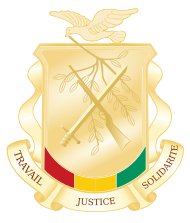Military of Guinea
| Republic of Guinea Armed Forces |
|
|---|---|

Guinea Military emblem
|
|
| Founded | 1958 |
| Service branches |
|
| Leadership | |
| Commander-in-Chief | President Alpha Condé |
| Minister of Defense | President Alpha Conde |
| Manpower | |
| Military age | 17 |
| Active personnel | Reported est. 45,000 |
| Expenditures | |
| Budget | $24.6 million (2006 CIA est) $36 million (2006 IISS est.) |
| Percent of GDP | 1.5% (2002) |
| Industry | |
| Foreign suppliers |
|
| Related articles | |
| History |
Portuguese invasion of Guinea Sierra Leone Civil War Second Liberian Civil War World War II (former French Imperial units only) |
The Republic of Guinea Armed Forces (French: Forces armées guinéennes) are the armed forces of Guinea. They are responsible for the territorial security of Guinea's border and the defence of the country against external attack and aggression.
Guinea's armed forces are divided into five branches — army, navy, air force, the paramilitary National Gendarmerie and the Republican Guard — whose chiefs report to the Chairman of the Joint Chiefs of Staff, who is subordinate to the Minister of Defense. In addition, regime security forces include the National Police Force (Sûreté National). The Gendarmerie, responsible for internal security, has a strength of several thousand, and is armed with military equipment. It is aided by the Republican Guard, which provides protection for government officials.
Upon independence in 1958, France cut all ties and immediately began to repatriate Guinean soldiers serving in the French Army. Of the about 22,000 Guinean soldiers in French service, about 10,000 decided to remain with France. The other 12,000 were demobilised and returned to Guinea. The new armed forces were formed by incorporating some of the former French soldiers, after a careful screening process to determine political reliability, with members of the former territorial Gendarmie to form the People's Army of Guinea (L'Armee Populaire de Guinee). By the end of January 1959 the new army had reached a strength of around 2,000 officers and soldiers.
In February 1969, the Guinean government moved against the armed forces after alleging that a plot centred in Labé, the centre of the Fula (French: Peul; Fula: Fulɓe) homeland was planning to assassinate Toure and seize power, or, failing that, force the secession of Middle Guinea. This followed military dissatisfaction over the creation of a PDG control element in each army unit. Later the alleged Fula connection was dropped, the accusations widened to other groups, and over 1,000 Guineans arrested. After the plot, the army was regarded by the government as a centre of potential subversion, and the militia was developed as a counterforce to any military threat to the government.
The army resisted the Portuguese invasion of Guinea in November 1970. Purges that followed the 1970 invasion decimated the upper ranks of the army, with eight officers sentenced to death and 900 officers and men who had reached a certain age retired from active duty. General Noumandian Keita, chief of the Combined Arms General Staff, was convicted and replaced by the army's chief of staff, Namory Kieta, who was promoted to general.
...
Wikipedia
